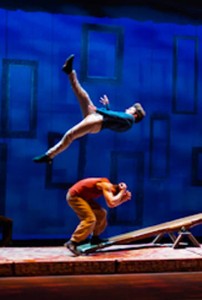Fuse Theater Review: Les 7 Doigts de la Main Return to Boston With the Innovative Artistry of “Sequence 8”
The agility of Les 7 Doigts de la Main’s acrobats may be the spectacle that draws audiences in to see Séquence 8, but it’s their decision to treat acrobatics as a form of acting that offers a new, intimate direction for the nouveau cirque genre.
Séquence 8. Conceived and performed by Les 7 Doigts de la Main. Artistic Direction by Shana Carroll and Sébastien Soldevila. Presented by ArtsEmerson. At The Culter Majestic Theatre, Boston, MA, through October 7.
By Ian Thal.
Les 7 Doigts de la Main is a 10-year-old, nouveau cirque troupe based out of Montréal. Unlike the traditional circus (with or without animals), where a show is a series of specialty acts that are only tangentially connected, the nouveau cirque genre is one in which the skills of circus are used to tell a story or explore a theme, and it is usually staged in a theater environment (as opposed to the circle of the traditional circus ring).
To understand the breadth of the genre, it is useful to note the difference between Les 7 Doigts and Montréal’s better-known nouveau cirque export, Cirque du Soleil. While the latter’s shows also feature a thematic or narrative through line, the virtuoso displays often have only a tenuous relationship to the larger story. Les 7 Doigts, by contrast, treats acrobatics as a form of acting, not as interludes between the more character-based pieces. Les 7 Doigts’ acrobats create a distinctive stage personae; their choreography uses acrobatics to elaborate character, story, and theme.
With the eight troupe members costumed in what appears to be a mixture of street and rehearsal clothing (designed by Manon Desmarais), the central theme of Séquence 8 is Les 7 Doigts de la Main itself. The individual segments of the program feature traditional displays of circus skills (such as leaps, somersaults, pole-climbing, or weight bearing), dance theater, and comic skits, all at the service of exploring the process of the work the performers do, the role that jealousy, camaraderie, love, and admiration play in the act of creation, the relationship the troupe members have with the audience, and how their performances are interpreted. Indeed, it should be noted that a number of the cast members studied and performed together as duos prior to joining Les 7 Doigts.
Sébastien Soldevila’s acrobatic design integrates the dance elements seamlessly: ensemble pieces are choreographed to exhibit a strong sculptural as well as thematic sense. Even in acts where the focus is on one or two members of the cast, the other acrobats are usually on stage, often acting as audience surrogates, or, in counterpoint to the free fall tumbling of the lead acrobat, members will dance in a more earthbound manner on the stage. The effect often generates intimacy: it is as if the audience has been invited to peek in on a rehearsal just as the artists are becoming aware of their talents and where they might lead.
Colin Davis, whose master of ceremonies role owes more to the casual archetype of the late-night television host in a loosely fitting jacket and tie than to that of the traditional circus ringmaster, quizzes the audience, makes quips about the acts that came before, and draws attention to the irony of a show that has been rehearsed to appear improvised at times. Eric Bates, who is the finest cigar-box juggler this reviewer has ever seen, plays the role of a shy yet likable person thrust into the spotlight. This routine is particularly amusing in the mock talk show interviews with Davis, where the metaphors customarily associated with the act of juggling are played to their absurd conclusion.
In exploring the thematic material, the acrobats also incorporate clowning skills, whether it is the grammelot dialogue of breath and sighs, character-based lazzias they watch each other’s acrobatic displays, or via traditional clowning routines, such as using mundane objects the wrong way. The ensemble members often preface their acrobatic displays with similar farcical misuse. For example, the teeter-totter act begins with attempts to use it solo and then with crawling under the board as if to figure out the basic principles of levers and fulcrums. The experimentation is followed by a debate about the act’s operative metaphor.
The agility of Les 7 Doigts de la Main’s acrobats may be the spectacle that draws audiences in to see Séquence 8, but it’s their decision to treat acrobatics and other types of circus virtuosity as a form of acting that offers a new, intimate direction for the nouveau cirque genre.
Besides being a playwright and critic for The Arts Fuse, Ian Thal also teaches mime and commedia dell’arte at the Somerville-based youth circus, OpenAir Circus.

